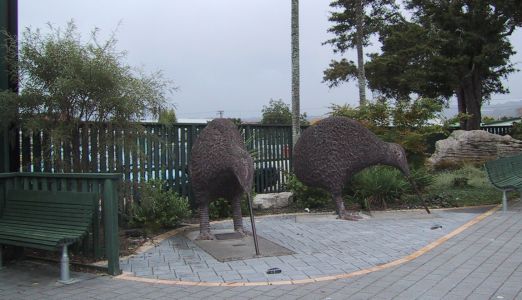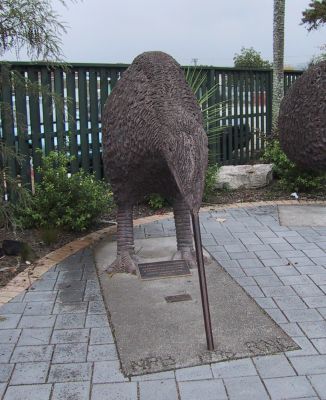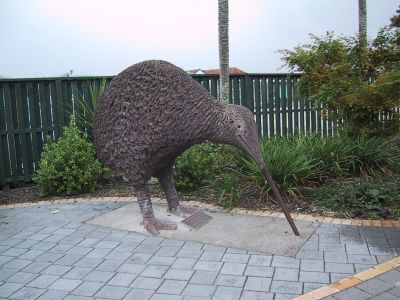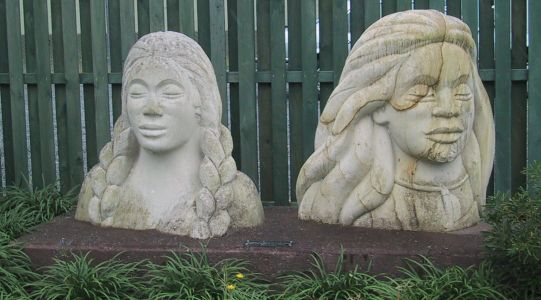|
| | This page is about the centre of the town of Otorohanga, in the Waikato
region of New Zealand.
Totems
One of the first sights that greets you are two mighty, carved totems,
depicting the eight Chiefs of the Ngāti Maniapoto Iwi (tribe). Carving is
a strong skill prevalent in Māori culture.

Maniapoto
Carved by Mitchell Hughes of Ngāti Maniapoto. Maniapoto was the great
fighting Chief and founder of the Ngāti Maniapoto Iwi (tribe). He
was the son of Rereahu, direct descendant of the Tainui Waka. His
leadership status is symbolised by the Korowai (cloak) he wears and
the Tewhatewha (axe-like weapon) he holds in the "Kawau Māro"
(triangular formation) position. Maniapoto had a pet eel, seen on
the carving as embracing him. The eel would swim in the stream near
Maniapoto's Cave, located south of Otorohanga. Three stalagmites symbolise
the cave where Maniapoto lived, as well as depicting his three wives. The
fourth stalagmite depicts his son Te Kawa Irirangi. The rope symbolises
the Kingitanga (the King Movement) led by the first Māori King,
Potatau Te Whero Whero.
Taonui
Carved by Martin Tuaupiki or Ngāti Mahuta. Words best used to describe
Taonui are Tohunga Ahurewa (High Priest) and Tino Rangitira (Great
Chief). The Toki Poutangata in his right hand denotes his Priestly
status. He holds a Tokotoko (walking stick) in his left hand and
wears a Korowai; portraying his Mana and his Rangatiratanga. His stance
shows readiness and alertness, typifying a Maniapoto warrior. Taonui was
noted for his Koauau (flute) playing. His own personal Koauau was
fashioned from the bone of an unfortunate donor. A Koauau has been carved
to adorn his neck.
Te Wētini
Carved by Martin Tuaupiki of Ngāti Mahuta. Te Wētini was a great
warrior in battle and has been portrayed as such. His stance might seem to
portray submission at first glance, but in fact he is ready and alert.
Hence the raised upper lip and "Niho Whakatete" (gnarled
teeth) grimace. Behind his back he holds a Tewhatewha to show
proficiency in two-handed weaponry as well as a Wahaika to show his skill
in close combat. The weapons are positioned to show humility; and only
when provoked will they be used. The Taura (rope) throughout the
pole represents "Te Aho o Tainui" (the genealogical strand
from whom all Tainui tribes derive).
Wahanui
Carved by Tahi Meihana of Ngāti Raukawa, Ngāti Rereahu. Wahanui holds
a Tokotoko (walking stick) indicating his oratory prowess; and the
Mana of his many riveting Whaikorero (speeches) to his own people
and fellow countrymen. The Manaia head on his right shoulder symbolises
the domain of Tumatauenga (God of War), and in contrast, the
surrendering of arms to become a Christian, is depicted by the Bible in
his left hand. Waiwaia, the name of the figurine on his left shoulder,
holds the Taurahere Tangata (the rope that links humanity). This
rope is the bond of our Tupuna (Ancestors) and the bond of our ties
with all of creation.
|

Tūhoro
Carved by Korari Boyd of Ngāti Haua. Tūhoro was a descendant of Te
Kanawa; and although he was a man of few words, he was indeed no less
influential, "He Tangata Ki Tahi" (a person of one word).
He lived mainly in Kawhia and Waitomo. When he found out that his land was
being confiscated, he consequently moved to Otorohanga and remained there.
Tūuhoro is depicted kneeling with a Patu (club) in his right hand
above his head as a challenge to his descendants to seek and be proud of
their origins. The spiralling form descending his left hand depicts not
only Ngāti Manipoto's Whakapapa (kinship) links,but it also
symbolises the Waipa River; a cherished waterway in Ngāti Manipoto. It
can be seen weaving its way down the carving, uniting the other Chiefs
below.
Te Kanawa
Carved by Desmond Te Kanawa of Ngāti Maniapoto. "te Kanawa, ki te
ringaringa nui hei whāwhā" (Te Kanawa, he with the strong hand).
The eldest son of Te Kawa Irirangi II and Urunumia, Te Kanawa was a great
warrior and a paramount Chief of Ngāti Maniapoto. He claimed direct
lineage to his ancestor Hoturoa, commander of Tainui Waka (canoe),
and he was a firm supporter of Potatau Te Whero Whero as first Māori King.
Known to have used his Taiaha (quarter staff) to pole-vault himself
out of danger, Te Kanawa is shown holding his Taiaha in the "Pahekeheke
Katau" position, a posture of defence. He also holds his Wahaika (short
club) in the "Hue Taepo" position, as a direct challenge to
those before him to uphold the Kingitanga movement.
Te Hauāuru
Carved by Albert Tipene of Ngāti Tuwharetoa. Te Hauāuru was a
descendant of Te Kanawa and his first wife Waikohika who also supported
Potatau Te Whero Whero as the first Māori King. During a conflict with
another Iwi intent on raiding and revenge, Te Hauāuru was given the only
gun held by a person of Ngāti Maniapoto at the time. Te Hauāuru helped
in defeating this onslaught by shooting the warrior who had the only gun
in the raiding party. Further, it is said that Te Hauāuru was also able
to avenge the death of his grandfather Maungatautari, formerly called Te
Hurinui who was killed some time earlier by the same Iwi, by shooting the
enemy's Chief.
Te Haupōkia
Carved by Tahi Meihana of Ngāti Raukawa, Ngāti Rereahu. Like Te
Hauāuru, Te Haupōkia was also a descendant of Te Kanawa and his first
wife Waikohika. Prior to the Kingitanga movement Te Haupōkia had attended
the Treaty of Waitangi meetings at Port Waikato and Kawhia along with his
father Nui Tone Te Pakaru; ultimately becoming a signatory to the Treaty
of Waitangi. Te Haupōkia also fought alongside Rewi Maniapoto at the
Battle of Orakau. He later travelled to Australia to help set up the flax
trade. This is depicted on the carving by the Harakeke (flax)
growing at his feet and the Kiekie hanging down by his up-raised hand.
|
|
Off to the rear left of the town green are a pair of large
sculptures.

This pair of Kiwis were sculpted by Robin Coleman, of Marton.
The plaques read:
"To the People of the Otorohanga District.
In appreciation of the
community support of our business over the last 25 years.
Donated by McDonald's
Lime Limited,
October, 1993."
|

|
 Otorohanga
is also home to the Kiwi House - a choice destination to see the lovely
birds first hand. Otorohanga
is also home to the Kiwi House - a choice destination to see the lovely
birds first hand.

|
|
On the other side of the green, the busts of Parehuia and Kahira
are found.
|

Parehuia and Kahira Maratini were two sisters, descendants of Ngāti Matakore.
Parehuia wore a moko (tattoo) on her chin depicting her female seniority in their family.
The two sisters were the original owners of this site which was called "Waikowhitiwhiti".
Neither sister had children of their own. It is the wishes of their
great-great-grand nieces and nephews to have them symbolically depicted on this,
their traditional whenua (land).
He Maimai aroha.
|
|
